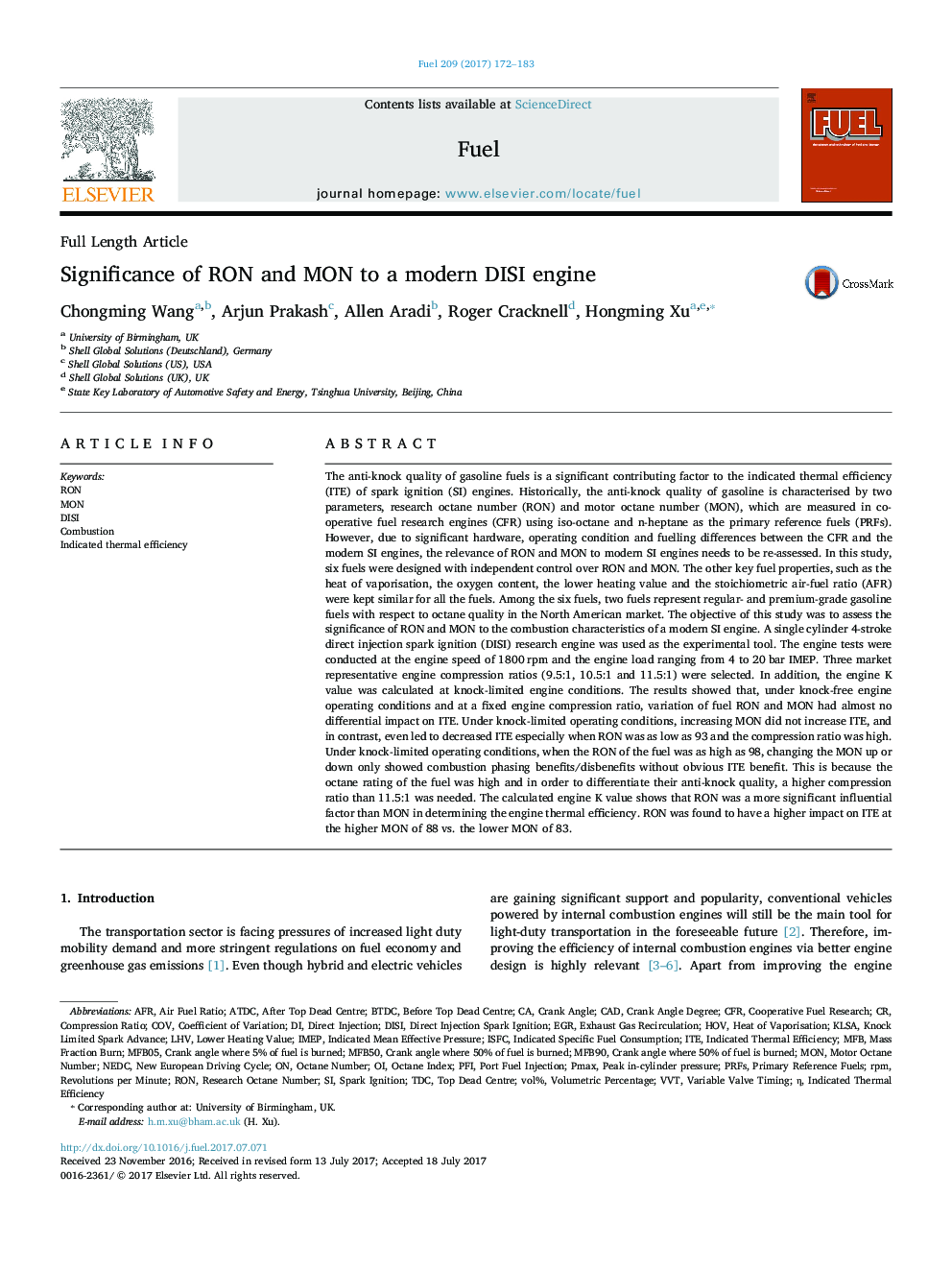| کد مقاله | کد نشریه | سال انتشار | مقاله انگلیسی | نسخه تمام متن |
|---|---|---|---|---|
| 6473839 | 1424955 | 2017 | 12 صفحه PDF | دانلود رایگان |
عنوان انگلیسی مقاله ISI
Significance of RON and MON to a modern DISI engine
دانلود مقاله + سفارش ترجمه
دانلود مقاله ISI انگلیسی
رایگان برای ایرانیان
کلمات کلیدی
RPMTDCISFCDISINEDCCFRPFILHVIMEPAFRMFBITEHOVPmaxMFB50VVTPRFSKnock Limited Spark AdvanceaTDCEGRbTDC - BTDCCOV - THECombustion - احتراقlower heating value - ارزش حرارت پایین ترResearch Octane Number - اکتان شماره تحقیقIndicated thermal efficiency - بازده حرارتی نشان داده شده استAfter Top Dead Centre - بعد از مرده مردهcooperative fuel research - تحقیقات سوخت تعاونیport fuel injection - تزریق سوخت پورتdirect injection - تزریق مستقیمOctane number - تعداد اکتانspark ignition - جرقه جرقهdirect injection spark ignition - جرقه مستقیم تزریقvol% - حجم٪crank angle degree - درجه زاویه دارRON - رونCrank Angle - زاویه میل لنگVariable valve timing - زمان بندی متغیر شیرrevolutions per minute - سرعت در هر دقیقهPrimary reference fuels - سوخت های مرجع اولیهOctane index - شاخص اکتانmotor octane number - شماره اکتان موتورCoefficient of Variation - ضریب تغییرCAD - طراحی به کمک رایانه یا کَدBefore Top Dead Centre - قبل از مرده مردهTop dead centre - مرکز مرده بالاIndicated Specific Fuel Consumption - مصرف سوخت خاص مشخص شده استMON - مونCompression ratio - نسبت تراکمAir Fuel Ratio - نسبت سوخت هواIndicated mean effective pressure - نشان دهنده فشار متوسط موثر استnew European driving cycle - چرخه ی جدید اروپاییMass fraction burn - کسر حجمی سوختگی داردexhaust gas recirculation - گردش بازگشتی گاز اگزوز
موضوعات مرتبط
مهندسی و علوم پایه
مهندسی شیمی
مهندسی شیمی (عمومی)
پیش نمایش صفحه اول مقاله

چکیده انگلیسی
The anti-knock quality of gasoline fuels is a significant contributing factor to the indicated thermal efficiency (ITE) of spark ignition (SI) engines. Historically, the anti-knock quality of gasoline is characterised by two parameters, research octane number (RON) and motor octane number (MON), which are measured in cooperative fuel research engines (CFR) using iso-octane and n-heptane as the primary reference fuels (PRFs). However, due to significant hardware, operating condition and fuelling differences between the CFR and the modern SI engines, the relevance of RON and MON to modern SI engines needs to be re-assessed. In this study, six fuels were designed with independent control over RON and MON. The other key fuel properties, such as the heat of vaporisation, the oxygen content, the lower heating value and the stoichiometric air-fuel ratio (AFR) were kept similar for all the fuels. Among the six fuels, two fuels represent regular- and premium-grade gasoline fuels with respect to octane quality in the North American market. The objective of this study was to assess the significance of RON and MON to the combustion characteristics of a modern SI engine. A single cylinder 4-stroke direct injection spark ignition (DISI) research engine was used as the experimental tool. The engine tests were conducted at the engine speed of 1800Â rpm and the engine load ranging from 4 to 20Â bar IMEP. Three market representative engine compression ratios (9.5:1, 10.5:1 and 11.5:1) were selected. In addition, the engine K value was calculated at knock-limited engine conditions. The results showed that, under knock-free engine operating conditions and at a fixed engine compression ratio, variation of fuel RON and MON had almost no differential impact on ITE. Under knock-limited operating conditions, increasing MON did not increase ITE, and in contrast, even led to decreased ITE especially when RON was as low as 93 and the compression ratio was high. Under knock-limited operating conditions, when the RON of the fuel was as high as 98, changing the MON up or down only showed combustion phasing benefits/disbenefits without obvious ITE benefit. This is because the octane rating of the fuel was high and in order to differentiate their anti-knock quality, a higher compression ratio than 11.5:1 was needed. The calculated engine K value shows that RON was a more significant influential factor than MON in determining the engine thermal efficiency. RON was found to have a higher impact on ITE at the higher MON of 88Â vs. the lower MON of 83.
ناشر
Database: Elsevier - ScienceDirect (ساینس دایرکت)
Journal: Fuel - Volume 209, 1 December 2017, Pages 172-183
Journal: Fuel - Volume 209, 1 December 2017, Pages 172-183
نویسندگان
Chongming Wang, Arjun Prakash, Allen Aradi, Roger Cracknell, Hongming Xu,